The Internet of Jobs is coming
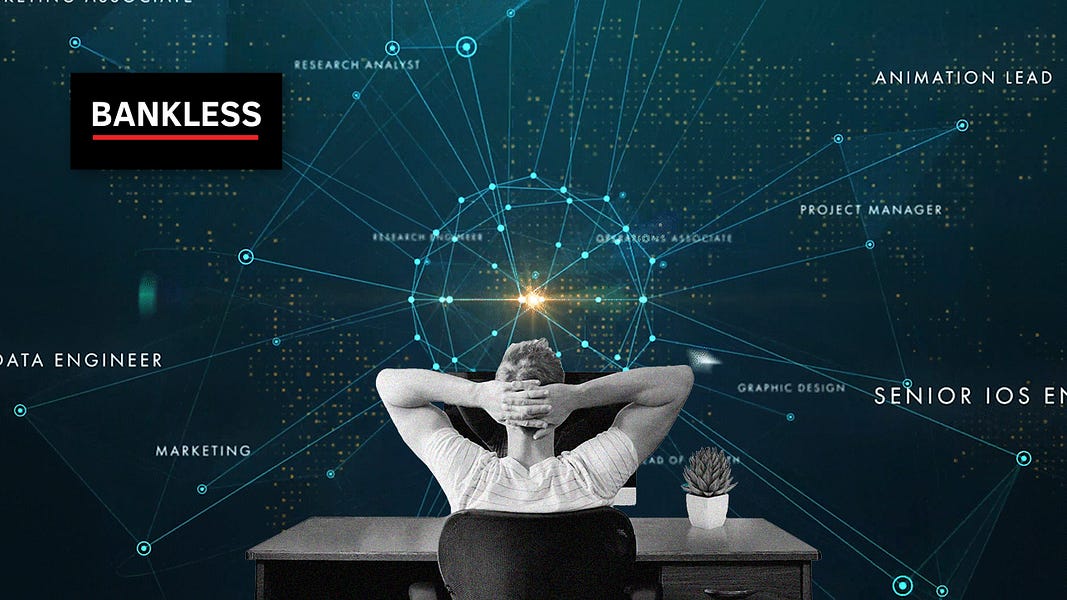
Dear Bankless Nation,
The internet has transformed work.
At first, work was geographically constrained. You worked on a farm, in an office, or in a factory. With the internet, you could work from anywhere in the world.
Not long after, we saw work go from one-to-many (employee to employer) to many-to-many (gig economy). Tech platforms connected people for transport, food delivery, tutoring, dog walking, and just about everything else.
But all of this work is bound by the legacy capital coordination system.
We didn’t have “internet native jobs” insofar as workers still had to rely on traditional banks and top-down organizations—even the Web 2 apps who were supposed to liberate ended up charging absurd take rates for their gig matching services.
But Web3 is changing everything.
Web3 reinvents the money system. In doing so, we create new and innovative ways to trade money for labor/value, without central points of failure.
We’ve only seen the world of internet-enabled jobs.
Kevin walks us through his vision of the Internet of Jobs.
This is how crypto goes mainstream.
- RSA
PS. Check out State of the DAOs #5 | Beginnings of the In-DAO-strial Revolution
The Internet of Jobs (IoJ) is what happens when web3 collides with the timeless exchange of labor for money in the digital realm. It creates a new and improved labor marketplace that integrates value transfer as a native feature, allowing our relationship with labor to be peer-to-peer and less reliant on central intermediaries with unilateral control.
The objective of this post is to articulate the size, scale, & scope of the internet of jobs (IoJ).
TL;DR
- The IoJ is going to happen.
- The IoJ is going to happen soon.
- The IoJ is how blockchains go mainstream.
- The IoJ is a wide-open design space.
- The IoJ is happening already.
The IoJ is going to happen
My argument here is one of first principles:
- The properties of blockchains networks imbue tokens with “moneyness”
- One of the primary uses of money is the purchase of labor or skills, more commonly known as “jobs.”
- Ergo, one of the use cases for blockchains will be “the internet of jobs”
The IoJ is going to happen soon
ICOs, NFTs, and DeFi are all major use cases for blockchains that have already been proven. They have created a multi-billion dollar marketplace for their products, and the emergent industry around these 3 use cases has created a class of knowledge workers who are crypto-native and paid in crypto.
Many crypto projects have elected to organize themselves as DAOs – internet native organizations. Because these new digital organizations employ many crypto-natives, DAOs are the catalyst for the internet of jobs.
The TAM (total addressable market) for the internet of jobs is massive. There are over 7 billion people in the world, and many of them would like to earn an income.
The IoJ is how blockchains go mainstream
The median internet citizen thinks about their job, not their investments when they think about their financial life & financial sovereignty. NFTs, yield farming, and meme coins may offer a great way to vibe with the crypto community, but it’s not enough for them to integrate crypto into their daily lives.
For 99% of the world, their financial lives are their jobs - not their investments. For this reason, I predict that Web3 won’t go mainstream until the internet of jobs is mainstream.
The IoJ is a wide-open design space
1. Framing the design space
The internet of information enabled computers to send information anywhere in the world. This radically changed anything in society that relies on information (entertainment, media, politics, social media). The internet of finance enables computers to send value across a computer network. This could radically change anything in society that relies on value transfer (banking, insurance, finance, art, jobs).
Of course, if you were trying to look to the future in 1997, it would be very hard to predict the rise of Google, Facebook, Twitter, or the iPhone. But looking back, it feels obvious. The use cases for the internet of jobs are similar. Looking forward in 2021, it’s hard to predict exactly what the breakout use cases will be.
2. Some IoJ tools will be skeuomorphic
Skeuomorphism is a term most often used in graphical user interface design to describe interface objects that mimic their real-world counterparts in how they appear and/or how the user can interact with them.
Whenever there is a new category of computing, the first products are usually Skeuomorphic.
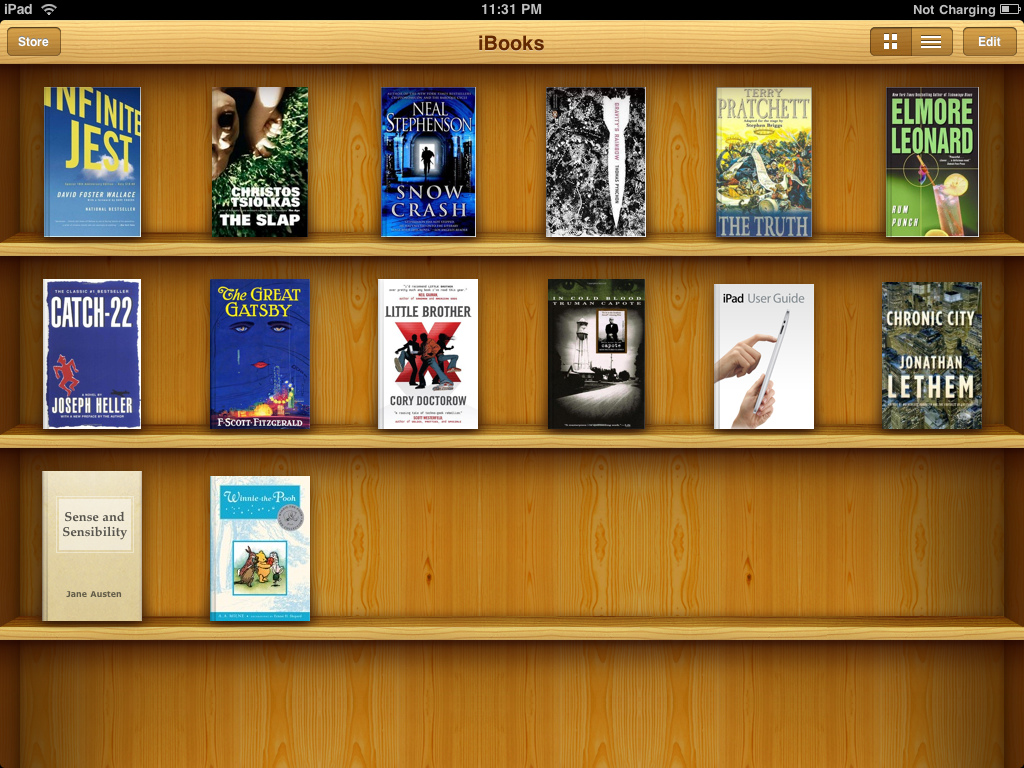
For example, when the internet happened, Yahoo and Google both had the same mission: to organize the world’s information. The difference?
- Yahoo just took the library card catalog system and put it online (a skeuomorphic way of solving the problem).
- Google invented a fundamentally new way of traversing information with the search bar (a non-skeuomorphic way of solving the problem).
The lesson here is that a lot of the value unlocked by the IoJ will be in fundamentally new, non-skeuomorphic, use cases that deliver value in ways that are both compelling & novel themselves. An IoJ-era example of Skeuomorphic vs non-Skeuomorphic mechanisms:
- LinkedIn is an example of a skeuomorphic use case, they’re just taking resumes and putting them online.
- Quadratic Funding is an example of a non-skeuomorphic way of funding talented people - it just didn't (and couldn’t) exist before.
3. The IoJ is not the Gig Economy
A common misconception is that the IoJ will be like the gig economy. It is true that gig sites like UpWork, Fiver, Uber, and others have been hallmark web2 marketplaces.
But they have been limited because they have shimmed onto the old financial system + the old internet. Without Ethereum providing easy tools to make such marketplaces transparent, immutable, global, or governable by their communities, the design space was much more limited.
We now have Ethereum, so we can build an IoJ that is more:
- Global, meaning you can participate from anywhere.
- Immutable, which means your assets can’t be seized.
- Transparent, which means no more information asymmetries
- Governerable by communities, creating more aligned incentives.
- Efficient because intermediaries have been replaced with smart contracts.
The IoJ is NOT just gigs. Gigs are part of the IoJ, but they are just one part of the design space.
4. Many important attributes will be unbundled from our legacy employment infrastructure & rebundled into the IoJ
There are many important benefits that are globbed onto the employment infrastructure in much of the world.
- Insurance
- Healthcare
- Retirement
- Protections against discrimination or other abuse
There are also other important attributes built into the employment infrastructure of the world:
- Taxation
- Regulatory Compliance
- Equality of opportunity
These attributes will be rebundled into the IoJ. Each of these attributes are important and worth their own post. An early example of this is the Opolis employment commons, a tool that shims many of the benefits from the legacy world (insurance, healthcare, etc) into the IoJ.
As the IoJ grows, new infrastructure will emerge that handles these attributes. As the infrastructure emerges, more people will work within the IoJ, creating a positive feedback loop.
5. Articulating the IoJ value function
Let’s get into the fun part: Designing mechanisms for an IoJ native world. Here is a generalized function of how ALL internet of jobs-era projects work:
token emission = f(time, materials, skills, work output, … other signals)
Read in plain English, the tokens you earn are the results of f(inputs) where inputs are the time, materials, skills, the value of the work output you create.
Bounties
One example in the crypto ecosystem are bounties:
Bounties are a common primitive in the crypto ecosystem. Gitcoin bounties itself has been used 8500+ times on Gitcoin to move over $5.55m in tokens!
In the bounties example, the mechanisms’ social contract is tokens exchanged for the delivery of some completed work, whether that be a pull request, security vulnerability, or design asset.
Grants
Grants are another commonly used crowdfunding mechanism. Many Web3 projects have their own grants programs as a way to compensate entrepreneurial teams to build on their protocols.
Gitcoin Grants matches contributions to your favorite projects with funds from a pool that GitcoinDAO maintains. Gitcoin Grants has distributed $25mm to hundreds of projects, and has seen over two million lifetime contributions.
In the Grants example, the mechanisms' social contract is that rewards are proportional to whether or not your peers are willing to fund your project.
Coordinape
Coordinape another unique tool commonly used to reward tokens for work completed. Unlike Grants and Bounties, which often compensate discrete packages of work, tools like Coordinape distribute tokens based on the value that peers have identified in your work.
Furthermore, Coordinape is a peer-to-peer compensation tool, allowing communities to participate in the act of giving and receiving, not dictated by a central authority. This turns compensation into a community-building event.
6. The IoJ will have many diverse implications beyond just money.
Of course it would be foolish to believe that you can boil down all this down to just money. There are many other implications on human welfare, and they will be explored as well. So really, the formula for the IoJ is not just
token emission = f(time, materials, skills, output, other signals)
Taking into account these things, we could restate the formula as
token emission + reputation + learning + impact = f(time, materials, skills, output, other signals)
It would not be an understatement to say that this is a multi-dimensional design space. There are a lot of possibilities here. So how should we explore it? What pitfalls should we avoid? Well... we should start by exploring mechanisms that match our values.
7. What are our Values?
Blockchains offer the ability to create smart contracts. In these smart contracts, we can literally program our values into our money. So what are our values?
This deserves its own post. What’s the relationship of capital to labor? How do supply and demand fit in together? How do we measure success? How to balance short-term incentives with long-term incentives? Where do social safety nets fit in? Where can we further align incentives? There are complicated political theories and economic histories to analyze, we have first principles arguments to make, and the surface area is extremely large. (If you want me to write a post about this, send me a tweet and let me know.)
That being said, I will provide my take on the “What are our values?” question though.
Caveat emptor, this is my individual opinion and is subject to change.
My present personal view is that the true endgame for the IoJ is to build a world that is abundant in each of the individual eight circuits of human consciousness for as many people as possible for as long as possible.
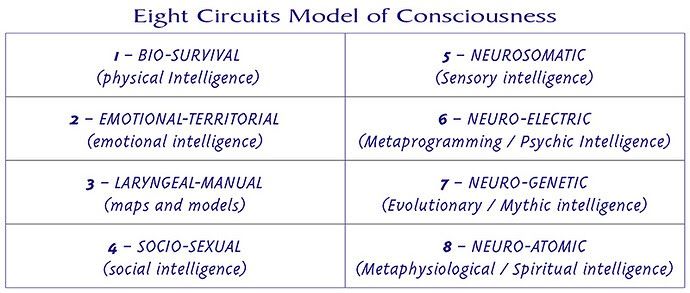
As you stack web3-native mechanisms on top of the eight circuits of consciousness, this is what you start to get:
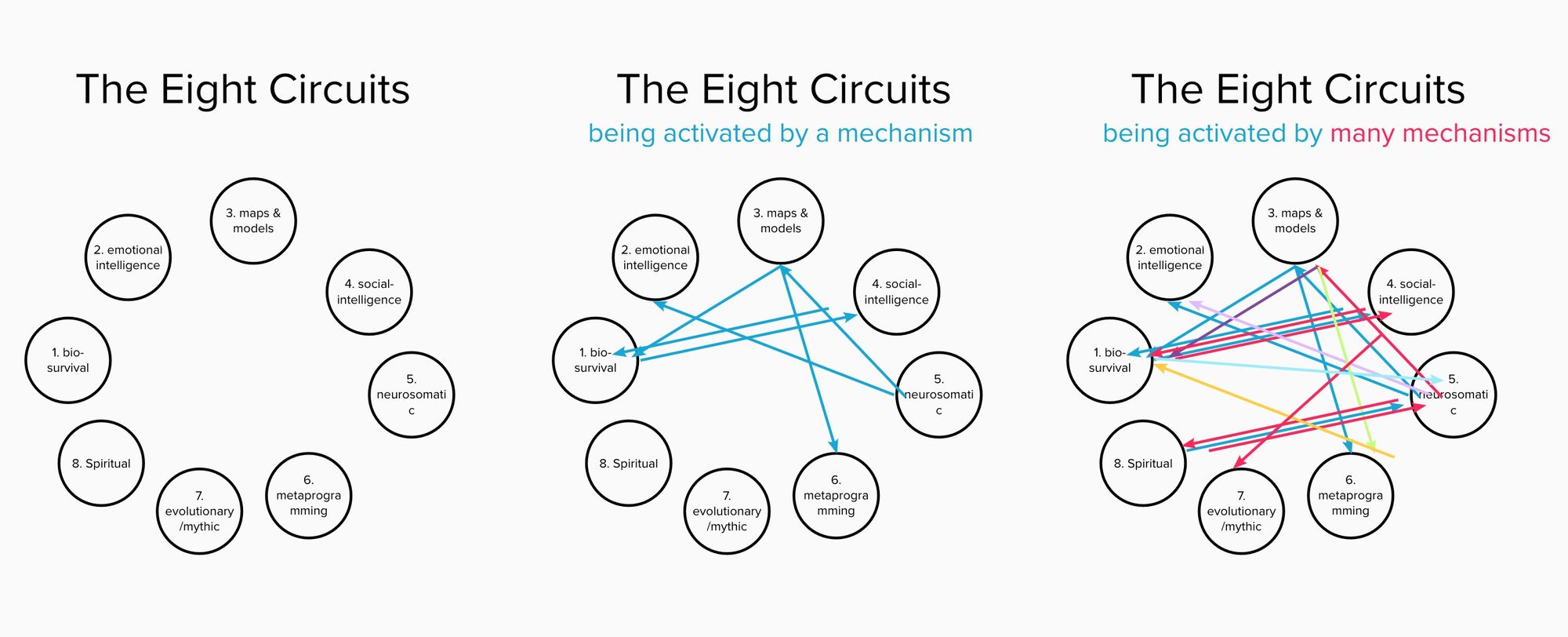
Further nuance is required when you consider there are multiple people involved in each transaction on the internet of jobs.
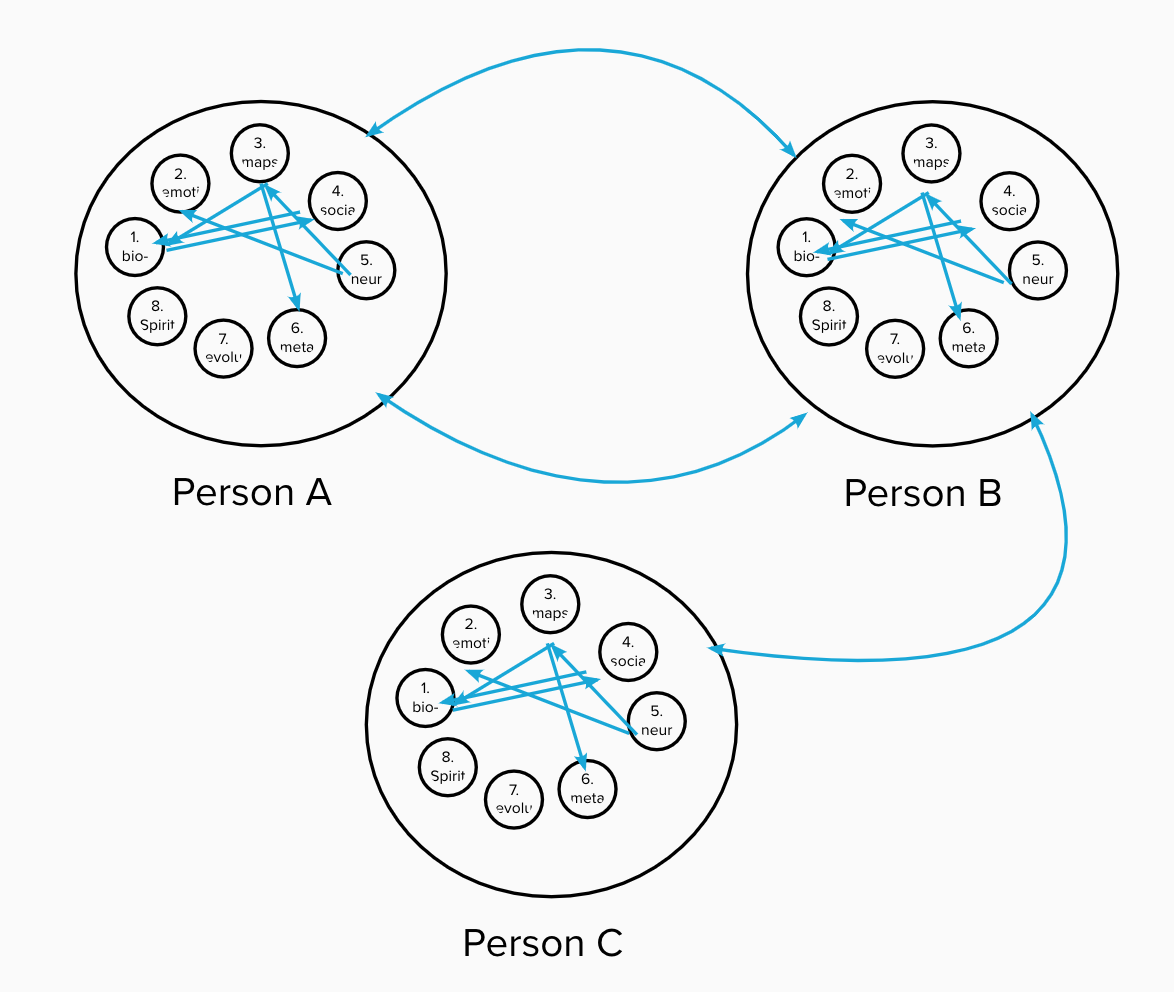
I think that one important design criteria are that persons should be able to:
- Mutually benefit
- Proportionally benefit to the value they each provided
- Have the option to walk away from any of these relationships.
This is not just theoretical. It’s happening already. Here is what a slice of the Gitcoin contributor graph looks like:
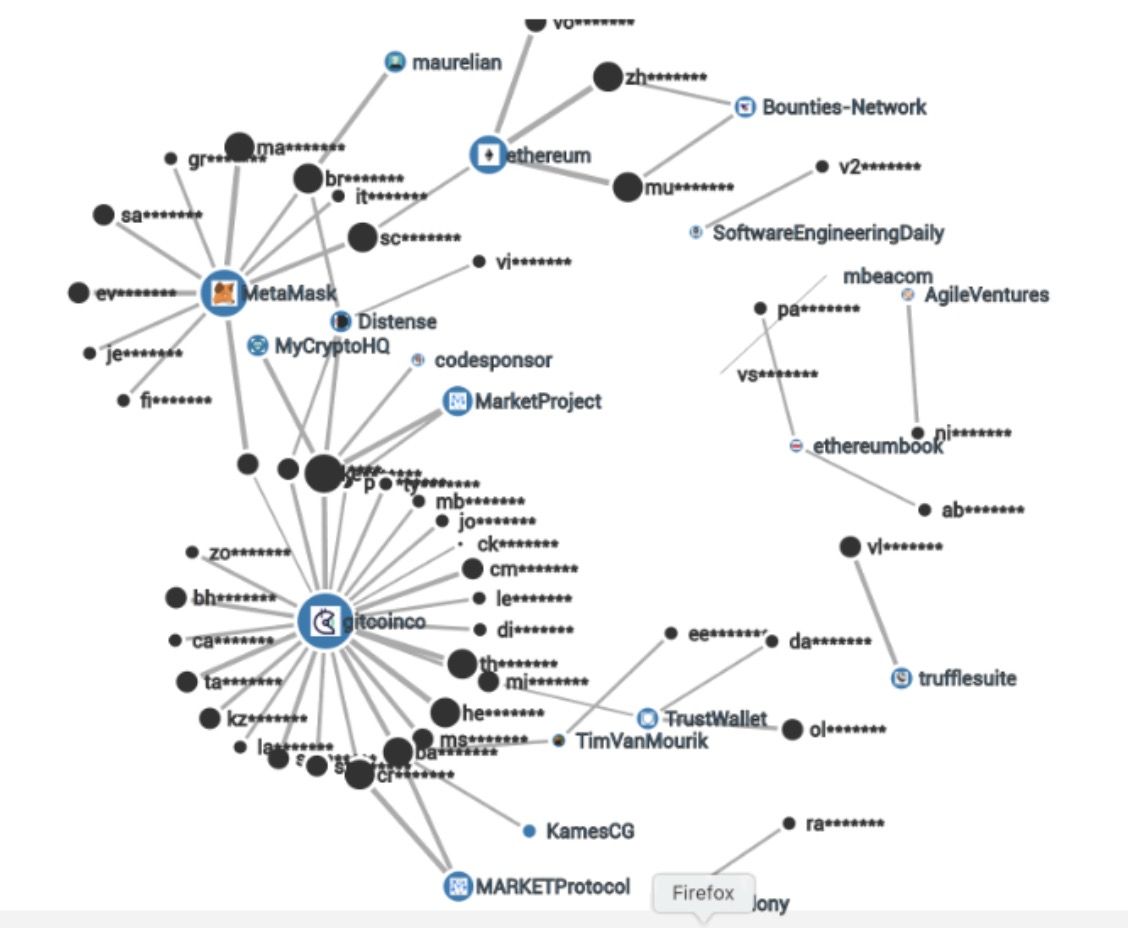
Even this view doesn’t do justice to the diversity of the humanity that will be using the Internet of jobs. Will the IoJ be accountable to humanity, or humanity accountable to it?
Will the IoJ create human thriving?
I’d like to believe we are designing a regenerative internet of value for the thriving of a global citizenry, an aggregation of 3-dimensional humans, each with differing values, ambitions, backgrounds, geographies, psychological orientations, financial endowments, privilege levels, abilities, and physical archetypes. We celebrate our diversity but also recognize our common human needs to live in healthy ecosystems, attain economic empowerment and maintain individual sovereignty.
I’d like to believe this. Maybe if other people would too, we can achieve a consensus on that north star and build it together.
The IoJ is happening already
The internet of jobs is already in motion. Here’s a list of internet of jobs products I’m aware of:
- SourceCred: A tool that measures an intersubjective consensus of where value is created in communities + creates token rewards for them.
- Radicle: A networked tool for earning tokens for OSS devs
- Opolis: An employment commons that handles common benefits + regulatory tasks.
- Coordinape: A tool that measures an intersubjective consensus of where value is created in communities + creates token rewards for them.
- OpenSea: A NFT marketplace where artists can sell their work.
- ETHGlobal: A hackathon provider; earn tokens for accomplishing coding tasks or starting something new.
- Gitcoin Grants: A quadratic funding based crowdfunding + matching tool.
- Gitcoin KERNEL: A web3 university
- Gitcoin Hackathons: A hackathon provider; earn tokens for accomplishing coding tasks or starting something new.
- Coordination Party Kit 7: A toolkit under development at Gitcoin for DAO-era employment.
- Bounty Board: A tool to distribute rewards for discrete tasks.
Some of these tools are skeuomorphic while some are fundamentally and radically new constructions of the internet of money era.
Did I miss any amazing IoJ tools? Let me know on twitter at twitter.com/owocki.
